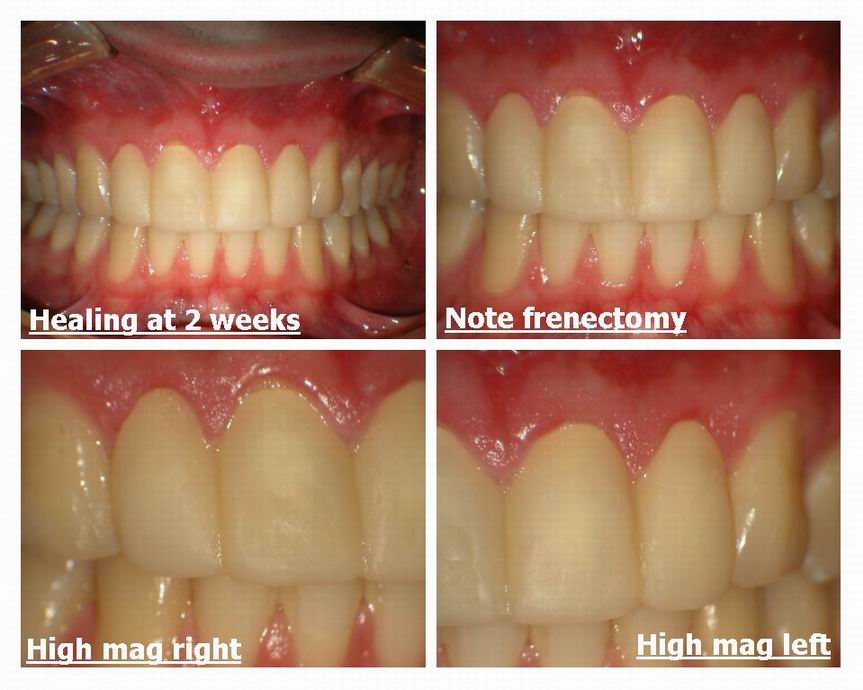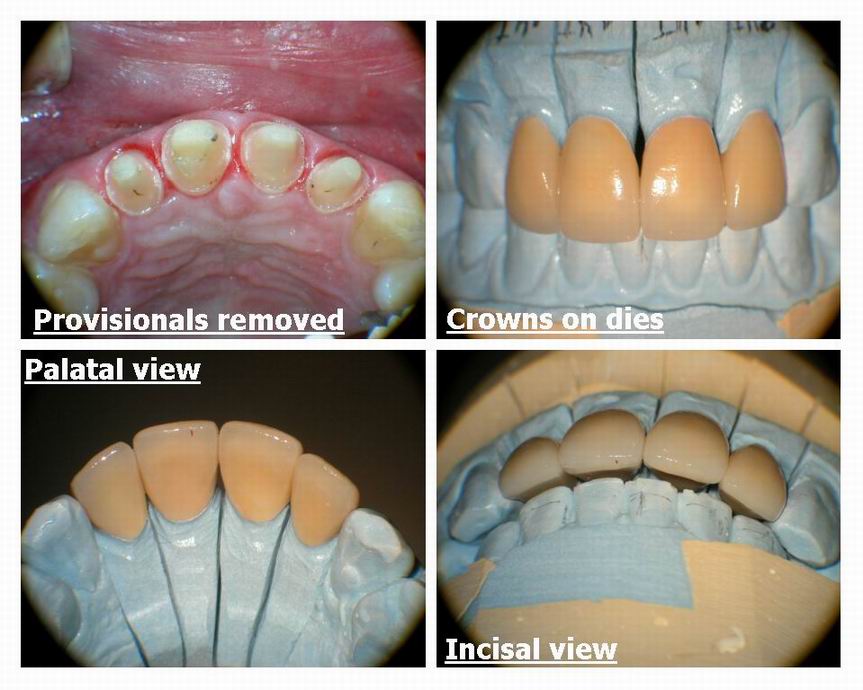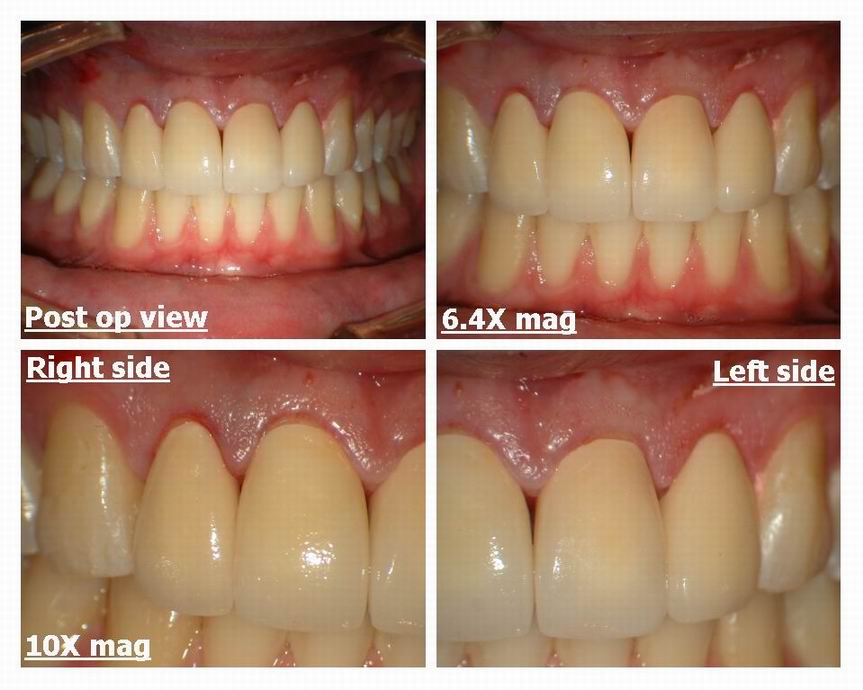Forum Replies Created
-
AuthorPosts
-
kellyjblodgettdmdSpectatorAl – It appears that this patient likes going to the dentist! Great work and documentation.
Kelly
ASISpectatorHi Bob,
Totally impressive sequence of treatment documentation. I see Glenn’s fingerprints all over this.
Again, tremendously well explained. Your post, like most other ones of yours, requires not just reading, but re-reading and note taking. Thanks again for sharing and educating.
How long did it take you to get down to apex?
Andrew
kellyjblodgettdmdSpectatorRon, Great questions. With regards to “what lesions would you stimulate?” – There is a great list of indications in the Table of Contents in Tuner & Hode’s new text “Laser Therapy”. You can view the T.O.C. on the web. Follow the link: http://ww.laser.nu/index.htm
Then click on “Now the New Book by Tuner/Hode”
Then click on “View the table of contents”
Look for Medical Indications and Dental Indications.
This will answer the questions of what conditions are treatable with laser therapy. I bought the text a couple months ago and it has been very helpful in understanding these concepts. It also has great descriptions of how different wavelengths affect tissues differently: i.e. shallow vs. deep lesions; chronic vs. acute lesions; etc.I think Bob gave a great “Cliff’s Notes” version of how the proposed cell activity occurs. And if this is the case, there aren’t any cells you couldn’t treat with laser therapy, given the right indications.
I find this field fascinating, and the amount of research which has been done over the last thirty years is astonishing.
Anybody have any other sources to list regarding biostimulation or laser therapy?
Kelly
mickey franklSpectatorThanks Ron for directing me to those sites.
The Periolase does seem to be the best perio laser.
But it took me afew months to convince myself the waterlase was the best allround laser for me.Is using the waterlase after root planing better than nothing ?
Can I use waterlase for smilelift crown lengthening?thanks
Mickey
kellyjblodgettdmdSpectatorRon, Thanks for the great article post. Do you ever talk to dentists who are bored with their profession? They sure as heck probably don’t own a laser (or two, or three, or…). I find this stuff so exciting, it’s sometimes hard to get to sleep at night.
I really appreciate this particular post. I’m speaking to my study club in a couple months about lasers in dentistry. They are all relatively skeptical about lasers. This will really help anwer questions regarding the validity of procedures such as laser ENAP. I can’t believe it. These are some of the most succesful and talented dentists in our city, but my goodness, are the minds closed!
Talk to you later.
Kelly
AnonymousSpectatorQUOTEQuote: from mickey frankl on 1:44 am on May 30, 2003
Is using the waterlase after root planing better than nothing ?
MickeyGood question.
How were you planning on using it? Biostim? In contact to remove soft tissue? Etching the root surface?
Mickey, I have a er,cr:YSGG and a diode.
After some time spent investigating wavelength and tissue effect, I believe there is a much better alternative. I’m sure there will be those who disagree (just look for the posts on DT who say ‘I don’t know how it works , I just care about the results I see in my practice’), but it’s difficult for me now to justify using either for perio. As another example, I would also have a hard time justifying picking up a handpiece now to remove bone in surgery (as opposed to the erbium). Its more of, not will it work, but is it the best ? Can I justify using it, if I believe something else is better?
BTW, what a great day for posts! Kelly, Bob, Alan- awesome,I’ve learned alot already today.Thanks!
Robert Gregg DDSSpectatorHi Kelly and Andrew,
Thanks for the very kind comments!
The pulse duration on the Pulsemaster is 100 microseconds. So it will indeed to the job nicely. I will have to check on the Pulsemaster we have at the office to see the best parameters to use. I will get back and post that.
But I hope this demonstrates one point about my purpose in my posts. Rarely do I speak about products or devices or brand names–unless there is a good reason to do so. I try to post in terms of parameters so that others with different devices of similar configurations can see what maybe they can do with the lasers they already have.
Yes, I am using a microscope for this. I’ve been using a Global Surgical microscope (like Glenn’s) for about 4-5 years, so I’m comfortable focusing it, keeping steady, etc while either I or my assistant Liz trips the shutter. In fact, yesterday, I signed a check for my lease payment for about 輾…..(isn’t that thing PAID for by now?!)
And yes, Andrew, you DO see Glenn’s fingerprints on these photos–and Ron S’s too. These guys have been great in helping me improve my image quality.
I took me about as long to get through to the apex as it did to get that great photo of you and your next door neighbors!:cheesy:
Seriously, since I was blocked in that one photo with the file in place (and out of flash memory), I removed the file, continued to lase down until I could see another opening, and placed the file, which went in about mid-root.
Then! I used Bisco 37% phosphoric acid as my chelating agent to negotiate the canal–which was very rough. I use this all the time. It MUST be Bisco though, as other A/E products have silca in their thickening agent. Even still it took 5 minutes or so.
I’ve been do this sort of canal opening for 12 years. And for 8 years I never needed to use a scope to do it. Only with microscope and digital photography is it now easier to accomplish and easy to share visually.
Glad you all like!
Oh, and before I leave this post–Thanks Del for those very kind words. Del was standing at my desk when I started reading his post (and saw my surprised reaction), and was able to thank him face-to-face, but I did tell him it was awefully nice for him to say those nice things. Let me tell you, Del is one incredible talent himself. He was my very first laser instructor before I purchased my first laser in 1990. I’m very lucky to have him as my partner!
His point about sharing and working together in order to learn and improve our patient care is an important one. Del and I are VERY lucky to have one another to work with, bounce ideas off each other, consult, debate, argue (easier to do face-to-face). But this forum, as I have told Ron many times recently (probably to his annoyance now) allows others to do the same via the Internet and this forum. Incredible!!
Bob
dilbertSpectatorOk. Below is the info we want to gather based upon the feedback. Please go ahead and send your answers via the message icon and I will start compiling the records.
brand
model
Purchase date
Has or will laser pay for itself Y/N
Training level
Total non-scheduled downtime since purchase
Number of failures since purchase
Last failure mode and date
Last service date
Service performed
Has any particular failure mode repeated and if so how many times and what was the mode of failure?Other comments
If you happen to have mulitple brands of systems, please make a note in your comments.
We also want to compile data on your flawless lasers so send in reports even if you have had 99.9% uptime.
Thanks for contributing.
(Edited by dilbert at 11:06 pm on June 2, 2003)
Robert GreggParticipantYep–
Try Amazon.com for this link for Tina Karu’s books and others:
http://www.amazon.com/exec/obidos/search-handle-form/102-2231011-1003358
Four references there.
And already mentioned by Kelly is Low Level Laser Therapy by Jan Tuner and Lars Hode book from Lasers, Inc (Larry Lytle, DDS) 605-342-5669 or 605-787-6045
Bob
Robert GreggParticipantAndy,
Good point about the journal and its status amongst the perio people.
And good thinking. 908nm near infra-red is VERY similar in effects to 1064nm (156nm difference), but probably penetrates through tissues even more than Nd:YAG. Other than that, they are very similar in effects on ox-redux stimulation from talking with the experts like Gregory Zeltzer, MD, PhD (a former colleague of Tina Karu at Pavlov’s Laser Institute in St. Pertersburg, Russia) and Glenn Calderhead, MD. 908 and other such diodes are so much more inexpensive, so that’s why so much research is done using those devices versus the much more expensive pulse Nd:YAGs at 1064).
Bob
Robert GreggParticipantOK Kelly,
QUOTE2) I have an ADT Pulsemaster 600. I’m not sure what the pulse duration is, but, to your knowledge, does the PM 600 deliver enough energy to do similar selective removal?Here are the Pulsemaster’s optimal power parameters for this sort of stuff:
It has a maximum Pulse Energy of 200 millijoules per pulse capability. I prefer more pulse energy for faster dentin cutting, but this ought to do nicely. It also has 100 usec pulse duration, so that’s a very good (short) pulse duration for hard tissue ablation (regardless of the wavelength, I think).
So your Pulsemaster will give you:
100 usec, 2.00 Watts at 10 Hz = 200 mj/pulse and 2000 watts of peak power.
That’s a heck of a lot more and BETTER energy delivery than I EVER had when I was using the dLase 300 for 8 years and opening up these kind of canals:
150 usec 3.00 watts 20 Hz = 150mj/pulse = 1000 watts of peak power.
Peak Power = pulse energy (.150 Joule) divided by pulse duration (.000150 seconds) = 1000 watts peak power.
So, Kelly, you have TWICE the energy per pulse as I ever had for 8 years!!. So you can do this nicely…
Thanks for the question.
Ooops! I almost forgot. Don’t forget the importance of the fiber diameter and its effects on the energy density!
If you have a 400 micron fiber, its energy density (intensity) is 159 Joules/cm2. With a 320 micron fiber the energy density is 249 J/cm2 which is 1.56 times more energy density than with a 400 micron fiber.
(So now you know my little secret for endo and pulsed Nd:YAGs. I always use a 320 micron fiber)
So for hard tissue ablation, you can increase your effective energy density, simply by switching to a smaller fiber diameter. If you don’t have a 320 micron fiber, I can get you one.
Bob
(Edited by Robert Gregg at 7:48 pm on May 30, 2003)
kellyjblodgettdmdSpectatorBob – Thanks so much for the walk-through. This really helps. I’m pretty good at math, but it’s been a while since Physics class! I have a patient coming in soon that I’ll try this out on. I was doing RCT on #31 (through a PFM) – found the MB and D canals, but couldn’t find the ML. Perhaps using an Nd:YAG in this fashion would be helpful.
I do have a 320 micron fiber; I also have a 220micron fiber. Would this be too focused or intense?Could you tell me a little more about your scope? I used on while I was a resident at the Veteran’s Hospital here in Portland – I loved it! I am wondering what magnification and gadgetry you have on it.
Thanks so much for your insight and assistance.
Kelly
AnonymousSpectatorQUOTEIf you have a 400 micron fiber, its energy density (intensity) is 159 Joules/cm2. With a 320 micron fiber the energy density is 249 J/cm2 which is 1.56 times more energy density than with a 400 micron fiber.
Bob
(Edited by Robert Gregg at 7:48 pm on May 30, 2003)
Bob, you lost me with this one.
The area of the 320um tip is only 25% smaller so I guess its not a simple proportion calculation.Where do those numbers come from? Is this assuming a certain power input?
Thanks
Glenn van AsSpectatorHi Guys….sorry for the delay in replying…..absolutely exhausted and had a couple of lectures to do. 600 emails later…….phew.
Anyways Ron, you can try to use water with the laser for soft tissue but I always turn mine off. If you were to leave it on I would only use a very very small amount. I have never done that because with the Hoya Delight the water know is not controlled by % like on the Waterlase. Next time, I will check it out by making only a very small spray come out. I like doing it without water, but your idea is valid. Remember though I am showing these cases at high mag and any case may look a little charred at these mags…..Good question though.
Al: thanks……they were pressed ceramic Empress veneers. I dont like the conical tip for the shaping of soft tissue , it cuts more like a knife. Great for frenectomies, for soft tissue biopsies but when I have used it for Class V I notched the root surface. If I was smart maybe the 400 micron tip would have been a little better to cut with. I think you need a tip with a cylindrical flat face to shave or plane the tissue with the erbium for sculpting. I really wasnt very good in this one on the erbium side in sculpting. Shows my errors.
Diode and Nd Yag would have looked as nice……(Nd Yag better if you are Bob!! GRIN)….
CO2 would char more.
Andrew …..great seeing you yesterday, have fun with the new laser and be patient even in your skilled hands there is a learning curve. Find out what you like doing with it and focus on that………
I agree with you that the frenectomy should have been done…..perfectly good idea. I missed on that one but will post another case in a minute that I finished this week where the frenectomy was done.
I might advise her to do it at the post op check…..thanks for pointing that out. These are the reasons I post things (not to be a holier than thou ) but I learn things and get ideas from others and see my work in a different light. I do become more critical as I look for the errors alot and in addition it is making me a better dentist. For the new people on this forum, dont be scared to ask a question even if it seems trivial and please post cases, because we all learn and you will too.
Hi Mickey…….I have included a picture of the scope in action so that you can see how we do things. One interesting thing is that with the microscope I literally am working and ask my assistant to press the shutter, so it is really easy to document these cases. I dont have to stop…..pick up the camera , get all focussed and then shoot….its easier and of course the magnfication is unsurpassed. It was a fluke that we got to this point with documentation , really the development of digital cameras and their ability to photograph without flashes in low light (increase ISO) helped amazingly , combined with new light sources…….
Hope that helps you Mickey and thanks for the kind words.
Bob, ……..thanks, coming from you with your knowledge of lasers that is very kind. Reading you post I thought to myself that yes the Nd Yag because it is pulsed is probably a good laser for beginners to use as it is more forgiving. Good point.
I sure hope to try the laser out one of these days. For those in Canada, Bob will soon be able to ship to Canada (talked to Chris Schmidt from the laser institute for Canada yesterday) and so you should be able to buy it soon.
I will post another case of 4 crowns that I am really proud of in a flash………
thanks guys………all nice comments.
Glenn
Glenn van AsSpectatorHi folks: Here is the finish of the case. Please look back at what we accomplished as the photos are at the top of this page.
THese are Empress crowns, custom shaded at the lab, and they were cemented in with Glass Ionomer.
Patient and I were very happy and I think the final result is pretty nice.
The frenectomy healed great and the contouring allowed for the gingival height of contour to be the same throughout the maxillary anterior.
One thing when you have a laser is you really start focussing on the height of contour in these cosmetic cases , especially those with a high smile line……….
I am going to actually post some post op photos when he comes back to show you how the tissue heals after I get my average fitting temps off. Hard to get a smile when they are so numb.
Hope you like it……….
Thanks
Glenn



-
AuthorPosts
